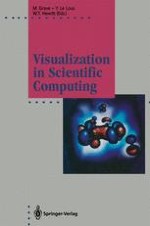1994 | OriginalPaper | Buchkapitel
Towards a Reference Model for Scientific Visualization Systems
verfasst von : W. Felger, M. Frühauf, M. Göbel, R. Gnatz, G. R. Hofmann
Erschienen in: Visualization in Scientific Computing
Verlag: Springer Berlin Heidelberg
Enthalten in: Professional Book Archive
Aktivieren Sie unsere intelligente Suche, um passende Fachinhalte oder Patente zu finden.
Wählen Sie Textabschnitte aus um mit Künstlicher Intelligenz passenden Patente zu finden. powered by
Markieren Sie Textabschnitte, um KI-gestützt weitere passende Inhalte zu finden. powered by
Reference models have been developed in various fields of information processing. The aim of such models is to define a unique basis for system development, system usage and for education and training.One of the first reference models in Computer Graphics was developed by Guedj et al[9]. Today, a (Standard) Computer Graphics Reference Model is under development by ISO[1]. In areas like CAD reference models have already been established on a national basis[4]. The ermerging Imaging standard[2] also defines a reference model for image operations.In Scientific Visualization various system models have been presented in recent years. These models focus on different aspects, such as a model for the visualization process, error accumulation, output pipelines in the visualization process, semantics of interaction in the visualization process, architecture and hierarchy of software modules, computing architectures and load sharing models, data and image interfaces.These models mostly have been set up by users than by developers of tools. Each of the above models does not reflect the meaning of scientific visualization for it’s own but just a certain view. Existing standards, like those known from Computer Graphics (GKS, PHIGS, …) are not covered by these models.This paper introduces a reference model for visualization systems and classifies existing models using the criteria of this reference model as a basis for comparison.
